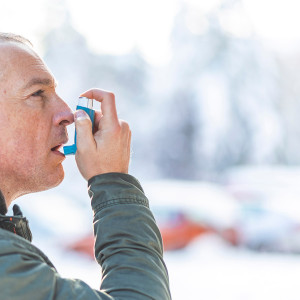Ambient air quality
Air pollution comes from both natural and human-made sources. The contaminant of most concern to human health in Canterbury/Waitaha is particulate matter (PM).
What is particulate matter?

PM is grouped into different size categories because size influences the impact PM has on health. Particles smaller than 10 microns are referred to as PM10, and those less than 2.5 microns, as PM2.5.
There is a substantial body of evidence that shows breathing particulate matter is harmful to human health. PM10 and finer particles such as PM2.5 can get deep into our lungs and cause health issues, particularly for vulnerable members of society like children, older people and those with respiratory illnesses.
PM2.5 comes from burning wood, coal, diesel and petrol. Particles larger than 2.5 microns come from dust, pollen and sea spray.
In Waitaha PM emissions have reduced over the last 20 years, as those living in the region have switched to cleaner home heating, although we still need to make significant improvements to our air quality.
View real-time air quality monitoring data.
What is ambient air quality?
Ambient air quality refers to the air outside buildings and structures. It does not include indoor air, the air inside workplaces, or contaminated air discharged directly from a source.
Here are some of the issues we face in Canterbury/Waitaha in relation to ambient air quality.
Issue: Poor ambient air quality affects our health and causes nuisance effects
 Air pollution does significant harm to many New Zealanders, including children. In 2016, human-made air pollution in New Zealand/Aotearoa – specifically PM2.5 (fine particles) and NO2 (nitrogen dioxide) resulted in an estimated:
Air pollution does significant harm to many New Zealanders, including children. In 2016, human-made air pollution in New Zealand/Aotearoa – specifically PM2.5 (fine particles) and NO2 (nitrogen dioxide) resulted in an estimated:
- 3317 premature deaths (in people aged 30+ years)
- 13,155 hospitalisations for cardiovascular disease (including 845 hospitalisations for childhood asthma)
- 13,229 cases of childhood asthma.
Over the last 20 years, ambient air quality has improved in our towns and cities as people living in Waitaha have switched to cleaner home heating. However, measurements show that PM and NO2 concentrations are still at levels that may adversely affect human health.
Trends in PM10 , PM2.5 , and NO2 in Waitaha airsheds can be seen in the graphs below.
The National Environmental Standard for Air Quality (NES-AQ) threshold concentration we exceed most often is for airborne particles smaller than 10 microns in size (PM10). The PM10 we see in our urban areas is generally from combustion sources but may include other sources such as dust, pollen or sea spray.
PM2.5 concentration guidelines
The World Health Organization (WHO) guidelines for PM2.5 concentrations are exceeded many times every year in all areas where we currently measure PM2.5. Whereas PM10 may include particles from non-combustion sources, PM2.5 is mainly generated by combustion sources including the burning of wood, coal, and oil-based fuels.
Other combustion-related pollutants include the carcinogen benzo(a)pyrene, for which past concentrations were more than 10 times higher than the annual guideline, and black carbon (soot) which can have detrimental impacts on health and contributes to global warming.
Managing air pollution
 There are eight polluted airsheds within Waitaha. The focus of our efforts in the majority of these areas is to improve winter air quality.
There are eight polluted airsheds within Waitaha. The focus of our efforts in the majority of these areas is to improve winter air quality.
In most cases, winter pollution in Waitaha is caused by inefficient wood burners and poor wood-burning techniques. This is worsened by the atmospheric conditions that create an inversion layer, trapping polluted air close to the surface of the earth.
Controls on home heating need to be balanced against the health effects of fuel poverty and living in cold, damp homes. These health effects can outweigh the benefits of requiring home heating to be less polluting if changes are not managed in a careful, considered way.
In the Washdyke airshed in south Waitaha, the focus of our efforts is different. Here, days of poor air quality often occur on workdays and during working hours and the PM10 includes more large particles than typically seen in other parts of urban Waitaha. These particles are most likely produced by work-related activities like the movement of vehicles on unpaved areas.
We have no recent air quality measurements outside our airsheds. It is likely that the human health impacts associated with poor air quality are occurring in other built-up areas in the region, and that emissions outside of our airsheds could impact on air quality inside our airsheds.
Current actions or approach
Maintaining and enhancing the quality of our air is essential to achieve the purpose of the Resource Management Act (RMA). We are responsible for managing air quality under the RMA and have responsibilities under the Local Government Act.
These responsibilities require local government to promote the four types of wellbeing (social, economic, environmental, and cultural) within the region. To ensure this is achieved, the planning framework in Waitaha must remain current and targeted toward managing any existing or emerging issues related to air quality.
We are responsible for managing emissions from home heating and industry, but not vehicle emissions, which are the responsibility of central government.
Chapter 14 of the Canterbury Regional Policy Statement (CRPS) sets the high-level direction for the management of ambient air quality. This chapter directs that ambient air quality must be maintained or improved and tasks us with controlling discharges to air via a regional plan and providing other assistance to the community through a range of non-regulatory actions.
The Canterbury Air Regional Plan (CARP) provides the regional plan policy response to managing ambient air quality within the Waitaha region. We also undertake a range of non-regulatory measures including home heating education and awareness campaigns and accredited firewood merchant schemes.
We recently published an air pollution risk report which identified other parts of Waitaha vulnerable to poor air quality.
We have no real-time NO2 measurements outside of Christchurch/Ōtautahi. We do have real-time black carbon measurements at a couple of our sites but there are no guidelines to compare these to and we have not yet compared these with measurements from elsewhere.Trends in PM10, PM2.5, and NO2 in the Waitaha airsheds
Over the last 20 years, ambient air quality has improved in our towns and cities as those living in Waitaha have switched to cleaner home heating. However, measurements show that PM and NO2 concentrations are still at levels that may adversely affect human health.
Trends in PM10, PM2.5, and NO2 in Waitaha airsheds can be seen in the graphs below.
These graphs show improvements in air quality over time, which differs in each airshed. Gaps indicate the years where monitoring had not yet started or did not take place. Hover over or click on a town name to focus on one airshed.
This monitoring data (up to 28/09/22) shows a general reduction in PM10. Since 1999 the number of days exceeding the national standard each year has reduced in most of our airsheds. In Washdyke a change of site in 2019 resulted in a higher number of exceedances than from the previous site.
This monitoring data shows a general reduction in PM2.5. Monitoring of this subset of PM10 started more recently. The number of days exceeding limits has reduced in most airsheds.
This monitoring data shows a general reduction in nitrogen dioxide (NO2). NO2 comes mostly from vehicle emissions. Monitoring of this gas is shown from two Christchurch/Ōtautahi sites, one roadside location in the Riccarton area and the other from a residential location in the St Albans area. This graph shows the number of days exceeding the 2021 World Health Organisation guideline. The NESAQ which applies to a different averaging period and has a different concentration limit, has not been breached at these sites.
